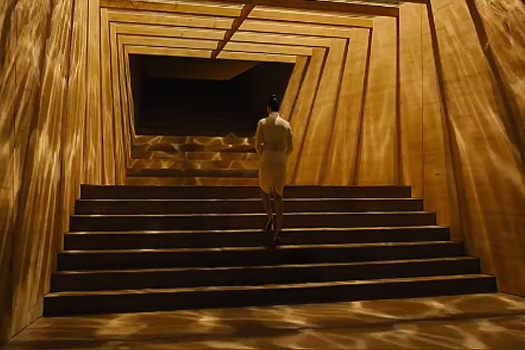“I cannot imagine making a film based on a screenplay I didn’t write. A director who makes a film entirely based on somebody else’s screenplay necessarily becomes an illustrator.” -Andrei Tarkovsky
“What an ugly beast the ape, and how like us.” -Cicero

Directed by: Denis Villeneuve
Written by: Hampton Fancher, Michael Green
Cast: Harrison Ford, Ryan Gosling, Ana de Armas, Jared Leto
SPOILERS ARE CONTAINED WITHIN THIS REVIEW
Blade Runner 2049 is a melancholic noir that follows replicant K as he pursues knowledge of a miracle replicant birth in a sequel that thoughtfully continues the exploration of what it means to be human with what it means to live and love. The designation “K,” while short for a serial number, hearkens to The Trial, a film by Orson Welles based on a story of the same name by Kafka. In it an accused man, Joseph K, attempts to discover the crime for which he is accused and defend himself against said undefined accusation. This inkling of pursuing the unknown in the dystopian The Trial can be felt in Blade Runner 2049, as well.
How one reacts to a Blade Runner film depends very much on expectations. Expecting an action film will lead to disappointment, while expecting thought-provoking philosophy and even soul-searching will yield fantastic results. Going back to the original 1982 film directed by Ridley Scott, a box office failure that became a small cult classic, was edited multiple times (seven versions, for heaven’s sake) and eventually came to be known as a science fiction/ tech noir classic and now a film classic beyond genre, we are given the seeds of what was almost universally considered a bad idea: a sequel that would continue the use of androids (replicants) to explore what it means to be human, or to simply be alive, whatever the nomenclature.
The main argument against such a sequel is, obviously, that the original will be tainted by association with an inferior sequel. Showing great respect to the audience and for such concerns, Blade Runner 2049, directed by Denis Villeneuve, written by Hampton Fancher (who wrote the original Blade Runner screenplay) and Michael Green and executive produced by Ridley Scott, delivers just about in every way possible to give respect to the original. The pacing and cinematography mirror the original while allowing Villeneuve and the illustrious Roger Deakins the space to construct their own vision without contradicting the original.
While the flow of energy and aesthetic were either ignored, misunderstood or maligned in 1982, our understanding of film has evolved. Mirroring the evolution of abstract art and its place in our culture, what cinematically baffled before is now commonplace, and we’ve learned much about the potential of the cinematic language over the last century and over the last third of a century since the original Blade Runner film, directed by Scott and photographed by Jordan Cronenweth.
Indeed, the cinematography of Blade Runner 2049 is quite beautiful. Clearly, a decision was made to balance clean lighting and design with the grit of the future. Although it occasionally rings hollow, most of the time it works. This is a mature, sophisticated film in the sense that it uses the forms of the original yet boldly avoids clouding them in unnecessary texture and ornament. For example, the extreme close up of the eye reflecting Los Angeles in Blade Runner is mirrored, but this time it is focused solely on an eye with no such texture, bringing us into the story from the context of the philosophical undertones of the film regarding life, identity and humanity.
The combination of different environments, both interior and exterior, creates the feeling of a complete world, something that I find myself consistently admiring about films associated with Ridley Scott. Brilliantly rendered cityscapes of vast structures disappearing into atmospheric perspective set us up for contrasting and/or complementary interiors, often flooded with moving light and shadow, as well as plentiful caustic light reflected and refracted via water. As beautiful as this is, however, it should be pointed out that there is no apparent motivation for this caustic light.
One could make the argument that it is simply the interior design of the future, but if so then what is it also doing within the decayed hideouts near the end? Perhaps if the film is referencing religion then caustic light should’ve been designed allegorically for the various flood myths with which our civilization is inundated, represented by the wrath of Wallace and the destruction of the older replicants, but it wasn’t. It just looks cool. More on this below.
Along with the amazing visual design, the filmmakers as well understand how powerful sound is and this knowledge is reflected in the amazing sound design and music. I was particularly worried about the music, written by Hans Zimmer and Benjamin Wallfisch, not so much because Vangelis, who scored the original, was not involved, but because his score was so integral to the world of the 1982 Blade Runner that a bad facsimile might ruin an otherwise good or great sequel.
Stanley Kubrick once remarked, about 2001: A Space Odyssey, that telling a composer to sound like Mozart or a Brahms would come up short and be a poor decision when you could just use the originals. To the credit of the Blade Runner filmmakers, however, they did about as good of a job translating Vangelis’ aural ambiance as one could hope. It did seem slightly contrived in spots but ultimately it succeeds in matching an important sound with the contemporary needs of 2049.
The characters are all believable, well-portrayed and well-acted. They are truly of this world. It’s a shame that Deckard, played by Harrison Ford, wasn’t a larger part of the film, as it would not only make other revelations (see below) more impactful, it would’ve added energy and humor (I refer you to a scene with a dog) to the film. While I applaud the filmmakers for respecting the slower pacing it would have benefited from Ford’s earlier presence.
Although there are a few unfortunate moments where sophomoric exposition raises its head and its bratty kid brother, explication, gives us the finger, the film mostly does a good job of allowing the audience to feel the impact of ideas rather than explaining them, such as when Deckard says, “Sometimes, in order to love someone, you have to be a stranger,” a line that has meaning in multiple directions in the film. For the most part the relationships work quite well, although I was initially confused about the relation between Deckard and K, or should I say Joe? When K becomes “Joe” (later sourced to a digital pleasure persona ad), you think it validates whatever ideas you may have had about a hypothetical father and son relation, although the truth is actually different.
I can understand why, all things being equal, having K as Deckard’s son would perhaps be too on the nose, too contrived (but the miracle birth isn’t?); as soon as the audience knows he’s looking for someone born 30 years earlier our cinematic knowledge and propensity to solve puzzles immediately points to K. As it is, however, the revelation regards a character about whom we care very little, as Dr. Ana Stelline, the memory designer and actual offspring, is just one stop among many, such that when we do realize that she is the miracle it is indeed a twist, but not a very powerful one.
It would’ve made more sense to have us believe that Stelline was Deckard’s daughter (and therefore compelling) earlier on, and then reveal it is actually K who is his son. This way you keep the irony and the ultra-noir of a man hunting himself and unwittingly endangering his father while searching for him without realizing it, all without losing the impact of the revelation. When K (Joe) apparently dies and they try to rhyme the emotion with the 1982 “tears in rain” soliloquy, it isn’t coming after a deflating revelation. It would be even more powerful because you just discovered their relationship and as you reflect back through the film he dies. You’d still have Stelline for future films while already caring about her more.
While most of the film delivers gorgeously due to the acting, direction, cinematography and sound, there are some misfires. Quality aside, one scene in particular was terribly misguided and poorly executed: the ridiculous love scene in which K’s digital girlfriend, Joi (Ana de Armas) syncs (or so she tries) with a prostitute in order that she and K may do the wild thang. I like the potential, if not the idea, but if you’re going to do it then it needs to be much more well-planned.
The lighting should have been different, darker, the layered effect was cumbersome and the shot design was simply and surprisingly flat. Why not use the caustic light here? At least it would be motivated: water-reflected and refracted light aesthetically represents the crossing of the digital with the physical, similarly crossing two mediums (Check out the big brain on Brad!). Next to Tommy Wiseau and Juliette Danielle in The Room, this may be the most awkward love-making in cinematic memory. In fact, this scene and the prostitution angle in general were both completely unnecessary. There are other ways to plant a tracking device without making us watch clumsy sex first.
In another strange scene a replicant being brought to “life” is unceremoniously dumped out of a giant Flush Puppies bag, landing on the ground with a rather inglorious thud. As with the love scene, but even more-so, such a scene should have taken advantage of its huge opportunity in light of the nature of the film. We did not get to see the actual birth from 30 years earlier, so at least show us this with more meaning and grandeur, and have it reflected in the direction, sound and cinematography. Yes, replicants are indeed meant only to be slaves, suggesting less than regal cinematic treatment, but no one in the audience, neither now, nor in 1982 nor somewhere between has seen a replicant coming to life. Maybe it happened when I got up to use the restroom but I think it was probably a wasted opportunity.
Indeed the film is long and, while I absolutely loathe saying this, I found myself wishing it would end. This was especially true when it began the segue into prepping me for yet another film, which I found annoying. Also troublesome are the threads growing between the Alien universe and the Blade Runner universe. Here Scott is using director Villeneuve to illustrate his grand design, one that heaps gobs of spirituality and mythology onto a scaffolding for which such was never intended. Not only was Alien a horror film with no such pretensions, Blade Runner is based on the book Do Androids Dream of Electric Sheep, written by Phillip K. Dick, a visionary author in his own right. The desire to combine such disparate sources this way seems rather dubious. Think of it; from a monster B movie to talk of Jesus being an Engineer merged with replicant miracle births … really now. Do you recall the growing bloat of The Matrix?
Spiritual and moral sophistication and power in cinema come not from cynically peddling grandiose myths but from showing the sublime in the mundane, the DNA in the fabric of life, a la Satyajit Ray, Yasujiro Ozu or the quoted Andrei Tarkovsky. The more some of these films try to elevate themselves to such lofty levels the more they convince me that they do not. Isn’t it neato enough that a man-made creature can self-replicate? Why does it need to be a miracle? Come on, it’s not a miracle at all; it’s an unexpected byproduct of an over-engineered tool. The lofty-minded geniuses (sorry, genii) at Tyrell and Wallace simply outwitted themselves; how smart can they really be? In truth, as with artificial intelligence in the real world, replicants are just another example of our technology outpacing our common sense (too bad there wasn’t an ironic scene of a replicant with tech-neck looking down at a phone update and falling into a manhole).
Definitely worth seeing, Blade Runner 2049 is a towering example of how to make movies with a big dash of how not to make movies. I credit the makers with respecting the audience in their quest to combine art and accessibility. As it turns out, however, the opening weekend was a box office disappointment, in some part due to the R-rating, doubtlessly required for the unnecessary and weak sex scenes. What works in this film is fantastic, which makes what doesn’t work that much more inexplicable and agitating.
Blade Runner 2049 might subjectively look better, or perhaps offer more of what we all love, but it’s not better than the original, nor does it need to be. Where the original sequel fears were justified, and while Villeneuve, himself, said that the chance of success was narrow, Blade Runner 2049 has justified its existence on its own merit by being a very beautiful and worthy addition. In the meantime, before it gets edited seven times, enjoy Blade Runner 2049 for what it is: a torn masterpiece, like its predecessor.



